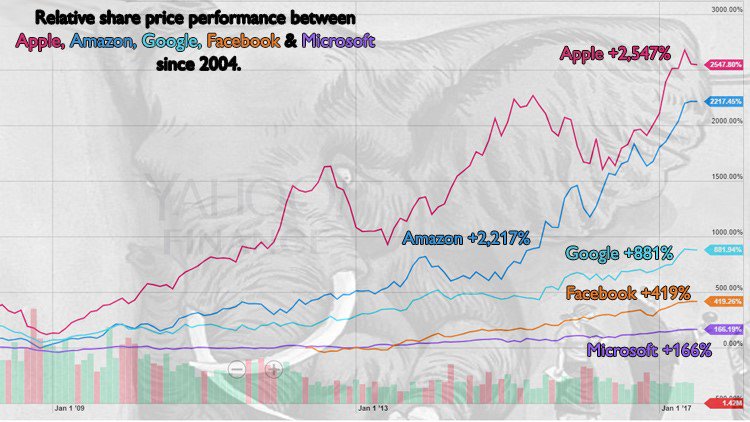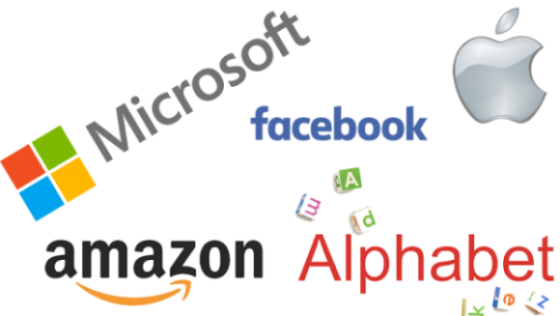The rise of the tech giants
Published 26-JUN-2017 15:12 P.M.
|
7 minute read
Hey! Looks like you have stumbled on the section of our website where we have archived articles from our old business model.
In 2019 the original founding team returned to run Next Investors, we changed our business model to only write about stocks we carefully research and are invested in for the long term.
The below articles were written under our previous business model. We have kept these articles online here for your reference.
Our new mission is to build a high performing ASX micro cap investment portfolio and share our research, analysis and investment strategy with our readers.
Click Here to View Latest Articles
The five largest companies on Earth are technology companies. Never before has this level of market influence been seen from just one sector, and from a handful of companies. What’s more astonishing is the rather short period of time taken to achieve such largesse.
The US-born, but now global, tech giants of Apple, Alphabet (Google’s parent company), Microsoft, Amazon and Facebook, are the five biggest companies in the world by market capitalisation, netting a combined US$2.2 trillion in market value.
Of course as with any investment there is still inherent risk in these companies and investors should seek professional financial advice if considering these stocks for their portfolio.
Their increasing dominance is fueling concerns about customer security and data privacy, not to mention the potential effects on anti-competition, anti-trust, tax avoidance and conflicts of interest issues.
As a taster of the power and influence these tech giants wield, consider the following statistics:
- Shares in Amazon and Alphabet raced passed the $1,000-mark this month, the latest sign of the companies’ growing might.
- Google is expected to attract more than 40% of digital advertising spend in 2017.
- Amazon is on track to collect half of US online sales by 2021.
- Facebook accounts for over 20% of total mobile internet traffic, and ushers more content through its servers each year than has been created by humankind in its prior history.
- Microsoft’s products, in one form or another, lurk in over 70% of PCs, mobiles, tablets, cloud servers and corporate networks.

The past performance of this product is not and should not be taken as an indication of future performance. Caution should be exercised in assessing past performance. This product, like all other financial products, is subject to market forces and unpredictable events that may adversely affect future performance.
Tech companies make routine buyouts of other, potentially competitive tech firms, at huge multiples and often for billions of dollars. Last year’s announcement of Microsoft buying LinkedIn (a social media platform for professionals) for $26 billion, shows just how high (and large) the stakes are for this new generation of corporate giants.
It used to be mostly banks and miners that wielded such largesse in market capitalisation, but not anymore.
The Top 5 Tech Firms Compared

Apple
Market value: $741 billion
Apple’s fiscal results for the fourth quarter ending September 2015 revealed revenue of $51.5 billion, an increase of 22% from last year’s fourth-quarter revenue of $42.1 billion.
Alphabet
Market value: $367 billion
Alphabet, the parent company under which Google operates, owns all of Google’s side projects, such as life-extension company Calico, innovative technology developer Google X, high-speed Internet provider Fiber and Google’s smart home project Nest.
Microsoft
Market value: $340 billion
Microsoft was founded in 1975 and launched Windows 3.0 in 1990. Microsoft employs close to 116,000 worldwide and posted annual revenue figures of US$93.58 billion and net income of $12.19 billion last year.
Market value: $231 billion
Facebook services around 1 billion users every day. The mass of data it has on users is attractive to advertisers, who pay handsome sums to direct targeted messages at their desired audiences with greater precision than they would have through traditional media, such as TV.
Facebook has grown at an exponential rate since its birthday in February 2004. Facebook acquired photo-sharing platform Instagram in 2012 and acquired messaging service WhatsApp for $16 billion in 2014.
Amazon
Market value: $483 billion
Amazon is an e-commerce giant, serving millions of global customers through its online marketplace. Amazon has added to its huge retailing unit, by introducing content streaming, music and video subscription services and cloud-based features.
Its most recent innovation is Amazon Go, a service feature which hopes to fundamentally “transform the retail world”. The system aims to make stores cashier-free by introducing a new self-check-out mechanism.
The engineer behind Amazon Go (Bali Raghavan), describes Amazon Go as a combination of sensor fusion, artificial intelligence and machine learning that automatically detects when products are taken from or returned to the shelves and keeps track of them in a customer’s virtual cart.
The other big news from Amazon is its pending acquisition of Whole Foods for $13.7 billion — a move that is likely to stretch Amazon’s influence into the perishables markets of food and beverages – as well as the hotly anticipated arrival of Amazon on Australian shores.
This acquisition is yet to occur, so investors should not base their investment decision on this information alone and should take a cautious approach to their investment decision.
The Power of Data
These firms gain power as they amass user data and shape the flow of information, controlling consumer access to the firms using their platforms. By becoming both the gatekeepers to e-commerce and tech revenue, as well as the catalysts for any new budding tech players, the top 5 tech firms have grown into corporate juggernauts within the space of two decades.
Cast your mind back to the early 2000s and the dotcom bust – at that stage, the top 5 tech companies featured in this article were relatively small in comparison to today, exercising barely a whiff of the influence. Back in 2000, only 10% of people had access to a PC or a mobile phone; today that figure is somewhere close to 90% in developed countries.
Such growth, in such a short time, has attracted the interest of regulators keen to restrain alleged rampant abuses of customer privacy protections and anti-competition laws designed to restrict runaway monopolisation.
Even Donald Trump has waded into the issue of tech dominance. Earlier this year, Trump described Amazon as a monopoly and said its boss Jeff Bezos had a “huge antitrust problem“.
Regulatory hurdles
Critics have said taking a tougher line on mergers and acquisitions won’t necessarily be enough to combat the rising power of giants like Amazon. And it would seem this has been borne out in recent years, with a generation of companies growing predominantly on the back of ‘value accretive acquisitions’ rather than through organic growth.
In 2013, the European Commission fined Microsoft for giving preferential treatment to its own browser, Internet Explorer. This year, it fined Facebook for providing “incorrect or misleading” information during its acquisition of messaging service WhatsApp.
Aside from some fines and critical commentary, the growth of the tech giants continues. The recent dramatic increases in share prices could be why some investors are underestimating the likelihood of regulatory action, or quite possibly, downplaying their ability to restrain the runaway Tech Locomotive.
A winning formula
In the world of corporate business, rapid expansion remains the default target of choice, and it seems it’s the tech companies that have found the winning formula.
Regulatory agencies from around the world have a huge task on their hands. Regulation is national, but the top five tech firms operate globally. Regulators see consumers on a national basis, but there is nothing to stop Aussie consumers paying for US-sourced content, sold by a US tech firm.
National regulation involves touchy subjects like national borders, tax rates and various legislation that is designed to protect national interests, rather than preserve efficient competition.
Regulators are desperate to put a lid on the insatiable growth of large tech firms – but in reality, there is very little they can do to stop them. The fundamental reason is that most consumers care more for the content or service they pay for than the potential hazards of just five global giants supplying it to them.
General Information Only
This material has been prepared by StocksDigital. StocksDigital is an authorised representative (CAR 000433913) of 62 Consulting Pty Limited (ABN 88 664 809 303) (AFSL 548573).
This material is general advice only and is not an offer for the purchase or sale of any financial product or service. The material is not intended to provide you with personal financial or tax advice and does not take into account your personal objectives, financial situation or needs. Although we believe that the material is correct, no warranty of accuracy, reliability or completeness is given, except for liability under statute which cannot be excluded. Please note that past performance may not be indicative of future performance and that no guarantee of performance, the return of capital or a particular rate of return is given by 62C, StocksDigital, any of their related body corporates or any other person. To the maximum extent possible, 62C, StocksDigital, their related body corporates or any other person do not accept any liability for any statement in this material.
Conflicts of Interest Notice
S3 and its associated entities may hold investments in companies featured in its articles, including through being paid in the securities of the companies we provide commentary on. We disclose the securities held in relation to a particular company that we provide commentary on. Refer to our Disclosure Policy for information on our self-imposed trading blackouts, hold conditions and de-risking (sell conditions) which seek to mitigate against any potential conflicts of interest.
Publication Notice and Disclaimer
The information contained in this article is current as at the publication date. At the time of publishing, the information contained in this article is based on sources which are available in the public domain that we consider to be reliable, and our own analysis of those sources. The views of the author may not reflect the views of the AFSL holder. Any decision by you to purchase securities in the companies featured in this article should be done so after you have sought your own independent professional advice regarding this information and made your own inquiries as to the validity of any information in this article.
Any forward-looking statements contained in this article are not guarantees or predictions of future performance, and involve known and unknown risks, uncertainties and other factors, many of which are beyond our control, and which may cause actual results or performance of companies featured to differ materially from those expressed in the statements contained in this article. S3 cannot and does not give any assurance that the results or performance expressed or implied by any forward-looking statements contained in this article will actually occur and readers are cautioned not to put undue reliance on forward-looking statements.
This article may include references to our past investing performance. Past performance is not a reliable indicator of our future investing performance.
